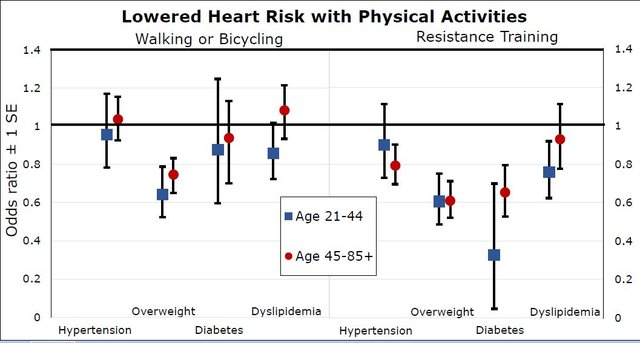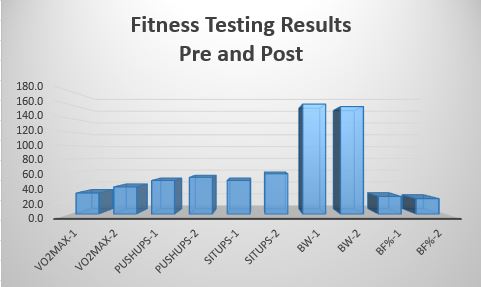BigTex
VET
- Joined
- Aug 18, 2023
- Messages
- 158
Studies show that high-intensity resistance training (70–90% 1RM) in older adults can improve VO2 max by 5–15% over 8–12 weeks, especially when combined with elevated heart rate and sufficient volume. So, resistance training can effectively enhance aerobic capacity in older adults by improving mitochondrial function and cardiovascular efficiency, particularly when heart rate is sustained in the high-intensity zone.
https://www.sciencedirect.com/science/article/pii/S1047279721001174
Functional Benefits: Improved aerobic capacity enhances stamina, reduces fatigue in daily activities, and supports cardiovascular health.

As I age, my goals in the gym have gone from all out strength to trying to stay out of a doctor’s office and live as long as possible. I do a protocol of lifting 85% of 1RM, one body part for 10 reps to failure, 5 sets, with 3–4 exercises, with 2-minute rests between sets, while reaching 85–95% of maximum heart rate (MHR). Max Heart Rate is determined by subtracting your age from 220. (220-age -= MHR). The take 85–95% of that figure to give you your training range. I use a FitBit smart watch to monitor my heart range while training. So I am able to see what my beats per minute are as soon as I finish each set to make sure I am using an intensity that keeps me in the target HR of 85-90% of MHR. This type of training mimics high-intensity interval training (HIIT), which is effective for improving VO2 max. Science has shown this type of exercise to be more effective than aerobics. High-intensity resistance training enhances oxygen utilization, mitochondrial density, and cardiovascular efficiency, all of which contribute to VO2 max improvements, even in older adults.
I have been training like this for a long time so I have adapted and able to recover from the workouts.
• Intensity (85% 1RM, 10 Reps to Failure): Lifting at 85% 1RM for 10 reps to failure is very demanding, as most individuals can only perform 6–8 reps at this intensity before failure.
• Sets and Exercises: I do 5 sets per muscle group, using 3–4 exercises. This is a high but manageable volume for me individually, totaling 15–20 sets per session. This provides sufficient stimulus for aerobic and strength/hypertrophy adaptations.
• Rest Intervals: I use 2-minute rests between sets allowing for partial recovery, maintaining heart rate in the target zone (85–95% MHR) and supporting cardiovascular stress.
Expected Outcomes
• VO2 Max Improvement: With 2–3 sessions per week for 8–12 weeks, even older adults can expect a 5–10% increase in VO2 max, depending on baseline fitness
You can estimate your Vo2max by using this calculator. Enter your age, your resting heart rate beats in 20 seconds.
https://www.omnicalculator.com/sports/vo2-max
• Functional Benefits: Improved aerobic capacity enhances endurance, reduces fatigue in daily tasks, and supports heart health.
• Heart Rate Zone: Sustaining 85–95% MHR during sets is key to VO2 max gains. A heart rate monitor can confirm this, as individual MHR varies. Perceived exertion (near-maximal effort) can also guide intensity.
What is VO2max?
VO2 max, or maximal oxygen consumption, is the maximum amount of oxygen that an individual can utilize during intense or maximal exercise and is generally considered the best indicator of cardiovascular fitness and aerobic endurance. So, as we age, not only is maintaining muscle mass important but so is cardiorespiratory fitness.
Why is VO2mas Important?
VO2 max is now widely used as an indicator of health. In 2016, the American Heart Association published a scientific statement recommending that cardiorespiratory fitness (CRF), quantifiable as VO2 max, be regularly assessed and utilized as a clinical vital sign. This statement was based on mounting evidence that lower fitness levels are associated with high risk of cardiovascular disease, all-cause mortality, and mortality rates stemming from various types of cancers.
Typical protocol
Frequency – 2-5 times per week depending on what kind of shape you are in
Intensity - 70–90% 1RM with a 85–95% MHR
Time – 3-5+ sets of 6-12 reps with 1-3 minute rest between sets (full body/push pull, body parts etc)
Type – concentrating on compound exercise as much as possible.
Recovery - Older adults need 48–72 hours between intense sessions. Prioritize sleep, nutrition (1.2–2.0+ g/kg protein daily), and hydration. The better shape you are in the quicker you will recover. Yes, anabolic steroids will help recovery.
https://www.sciencedirect.com/science/article/pii/S1047279721001174
Functional Benefits: Improved aerobic capacity enhances stamina, reduces fatigue in daily activities, and supports cardiovascular health.

As I age, my goals in the gym have gone from all out strength to trying to stay out of a doctor’s office and live as long as possible. I do a protocol of lifting 85% of 1RM, one body part for 10 reps to failure, 5 sets, with 3–4 exercises, with 2-minute rests between sets, while reaching 85–95% of maximum heart rate (MHR). Max Heart Rate is determined by subtracting your age from 220. (220-age -= MHR). The take 85–95% of that figure to give you your training range. I use a FitBit smart watch to monitor my heart range while training. So I am able to see what my beats per minute are as soon as I finish each set to make sure I am using an intensity that keeps me in the target HR of 85-90% of MHR. This type of training mimics high-intensity interval training (HIIT), which is effective for improving VO2 max. Science has shown this type of exercise to be more effective than aerobics. High-intensity resistance training enhances oxygen utilization, mitochondrial density, and cardiovascular efficiency, all of which contribute to VO2 max improvements, even in older adults.
I have been training like this for a long time so I have adapted and able to recover from the workouts.
• Intensity (85% 1RM, 10 Reps to Failure): Lifting at 85% 1RM for 10 reps to failure is very demanding, as most individuals can only perform 6–8 reps at this intensity before failure.
• Sets and Exercises: I do 5 sets per muscle group, using 3–4 exercises. This is a high but manageable volume for me individually, totaling 15–20 sets per session. This provides sufficient stimulus for aerobic and strength/hypertrophy adaptations.
• Rest Intervals: I use 2-minute rests between sets allowing for partial recovery, maintaining heart rate in the target zone (85–95% MHR) and supporting cardiovascular stress.
Expected Outcomes
• VO2 Max Improvement: With 2–3 sessions per week for 8–12 weeks, even older adults can expect a 5–10% increase in VO2 max, depending on baseline fitness
You can estimate your Vo2max by using this calculator. Enter your age, your resting heart rate beats in 20 seconds.
https://www.omnicalculator.com/sports/vo2-max
• Functional Benefits: Improved aerobic capacity enhances endurance, reduces fatigue in daily tasks, and supports heart health.
• Heart Rate Zone: Sustaining 85–95% MHR during sets is key to VO2 max gains. A heart rate monitor can confirm this, as individual MHR varies. Perceived exertion (near-maximal effort) can also guide intensity.
What is VO2max?
VO2 max, or maximal oxygen consumption, is the maximum amount of oxygen that an individual can utilize during intense or maximal exercise and is generally considered the best indicator of cardiovascular fitness and aerobic endurance. So, as we age, not only is maintaining muscle mass important but so is cardiorespiratory fitness.
Why is VO2mas Important?
VO2 max is now widely used as an indicator of health. In 2016, the American Heart Association published a scientific statement recommending that cardiorespiratory fitness (CRF), quantifiable as VO2 max, be regularly assessed and utilized as a clinical vital sign. This statement was based on mounting evidence that lower fitness levels are associated with high risk of cardiovascular disease, all-cause mortality, and mortality rates stemming from various types of cancers.
Typical protocol
Frequency – 2-5 times per week depending on what kind of shape you are in
Intensity - 70–90% 1RM with a 85–95% MHR
Time – 3-5+ sets of 6-12 reps with 1-3 minute rest between sets (full body/push pull, body parts etc)
Type – concentrating on compound exercise as much as possible.
Recovery - Older adults need 48–72 hours between intense sessions. Prioritize sleep, nutrition (1.2–2.0+ g/kg protein daily), and hydration. The better shape you are in the quicker you will recover. Yes, anabolic steroids will help recovery.

